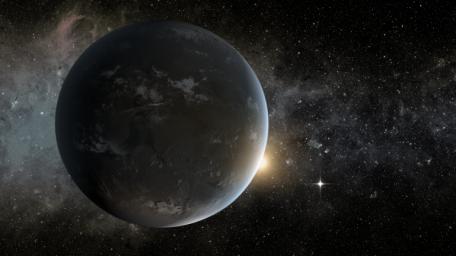
|
Morning Star (Artist Concept)
- Click the image above for a larger view
- Full-Res JPEG (4268 x 2400) (1.2 MB)
- Full-Res TIFF (4268 x 2400) (30.8 MB)
Caption:
This artist's concept depicts in the foreground planet Kepler-62f, a super-Earth-size planet in the habitable zone of its star, which is seen peeking out from behind the right edge of the planet. The small shining object farther to the right is Kepler-62e, which orbits on the inner edge of the habitable zone of the star, and is roughly 60 percent larger than Earth. If someday in the distant future, we landed on the right spot on Kepler-62f, just before "sunrise," we'd be treated to a lovely view of Kepler-62e as a "morning star" much like Venus often appears for us on Earth.
Kepler-62f is NASA's Kepler mission's smallest habitable zone planet found yet, but its star, located about 1,200 light-years from Earth in the constellation Lyra, is smaller, cooler, and older than the sun. Kepler-62f orbits every 267 days and is roughly 40 percent larger than Earth in size. Although the size of Kepler-62f is known, its mass and composition are not. However, based on previous exoplanet discoveries of similar size that are rocky, scientists are able to determine its mass by association.
Background Info:
NASA's Ames Research Center in Moffett Field, Calif., manages Kepler's ground system development, mission operations and science data analysis. JPL managed the Kepler mission's development.
For more information about the Kepler mission, visit: http://www.nasa.gov/kepler .
Cataloging Keywords:
| Name | Value | Additional Values |
|---|---|---|
| Target | Kepler-62 | |
| System | Kepler-62 | |
| Target Type | Exoplanet | |
| Mission | Kepler | |
| Instrument Host | Kepler | |
| Host Type | Space Telescope | |
| Instrument | ||
| Detector | ||
| Extra Keywords | Artwork, Color, Infrared, Orbit | |
| Acquisition Date | ||
| Release Date | 2013-04-18 | |
| Date in Caption | ||
| Image Credit | NASA/Ames/JPL-Caltech | |
| Source | photojournal.jpl.nasa.gov/catalog/PIA17002 | |
| Identifier | PIA17002 | |
